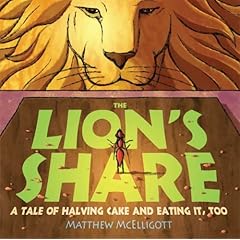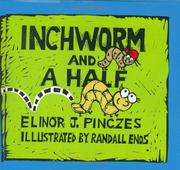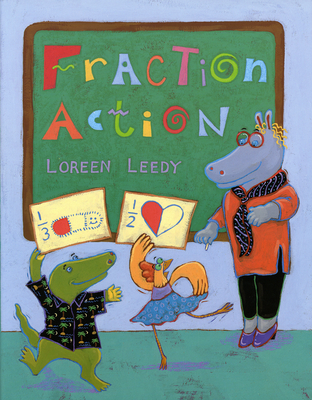In second grade, students study fractions. Students learn how to identify and represent fractions, compare unit fractions, and write fractional values (SOL 2.3). The resources provided below will support instruction during the second grade unit on fractions.

The Lion’s Share: A Tale of Halving Cake and Eating it, too
Written and Illustrated by Matthew McElligott
The Lion’s Share: A Tale of Halving Cake and Eating it, too is a story about an ant that is invited to join the lion’s dinner party. Throughout the dinner the ant observes the other animals’ rude behavior and unwillingness to share fairly. When the lion presents his guests with a large cake, the other animals take turns halving the dessert until there is nothing left but a crumb for the ant and the lion to share. As a gesture of goodwill, the ant offers to bake the lion a new cake. Meanwhile, the other guests refuse to be outdone. They continue to double the ant’s offer until the last guest offers to make 256 cakes! This tale of halving and doubling will help students to visualize the relationship between fractions, multiplication, and division.

The Wishing Club: A Story About Fractions
Written by Donna Jo Napoli and Illustrated by Anna Currey
In The Wishing Club: A Story About Fractions four children wish on a star. They soon discover that each child only receives a fraction of his or her wish. For example, Petey wishes for a dollar but only receives a quarter. This cycle of fractional wishes continues until Samantha designs a plan. The children work together to combine their fractional values into one whole wish. This book highlights unit fractions, comparing fractions, and adding fractions to create one whole.

Give Me Half!
Written by Stuart J. Murphy and Illustrated by G. Brian Karas
Give Me Half! tells the story of two siblings who do not want to share. The mother intervenes and insists that the children share everything equally. She tells her children to divide the food into halves. As the story continues the children learn how to divide solids, liquids, and parts of a set into halves. The illustrations are accompanied by pictorial and numerical representations of the children’s fair shares. For example, a diagram illustrates two halves of a pizza forming one whole. Underneath this illustration the is the number sentence 1/2 + 1/2 = 1 whole. This book will help students visualize the fraction one half in a variety of ways.

Inchworm and a Half
Written by Elinor J. Pinczes and Illustrated by Randall Enos
Inchworm and a Half is a tale about an inchworm that has set out to measure all of the vegetables in her garden. The inchworm’s stride measures one inch in length. Therefore, measuring the garden is as easy as counting her steps. One day the inchworm realizes that one of her measurements is in between two whole numbers. She cannot measure this length with her stride. In order to finish measuring the garden, the inchworm asks for help from the 1/2-inch, 1/3-inch, and 1/4-inch worms. Together they are able to measure the vegetable garden. This book focuses on unit fractions and their relationship to one whole.

Fraction Action
Written and Illustrated by Loreen Leedy
Fraction Action is divided into five chapters. In each chapter Miss Prime teaches her students about a different aspect of fractions. Her first lesson teaches students about equal parts as well as halves, thirds, and fourths. She emphasizes that any whole shape can be divided into fractions. The second lesson focuses on parts of a set. In this chapter students learn to identify fractional parts of a group. The third chapter highlights the importance of fair shares and equal parts. The next chapter focuses on the relationship between fractions and money. The book concludes with a fraction test. Miss Prime tests her students’ knowledge of fractions through a review game. Each mini lesson could be read aloud throughout the fraction unit. The book’s word problems and puzzles will keep students engaged as they learn about the many uses of fractions.
Student Resources
- Flitting with Fractions: Students learn to identify fractional parts of a group with this interactive online game.
- Fraction Shoot: This game has four tiered levels that help students recognize fractional values. In the first level, students learn how to discern between equal and unequal parts. As the levels progress, students learn about halves, thirds, and fourths.
- Fraction Flags: Students create flags using the required proportions. Through this activity students learn the different ways to represent halves and fourths. Click here to create fraction flags using thirds.
- Naming Fractions: Students write the fraction that corresponds with the highlighted portion of the shape.
- Fraction Domino Cards: Students can practice their fraction skills at home with these printable domino cards.
Teacher Resources
- Fish Fractions: Use this file folder game to teach students how to read, write, and identify fractions.
- Fractions Smartboard Activity: This Smarboard activity can be used with whole class or small group instruction. Through this activity students will learn how fractions are used in daily life. Students will also be required to match fractional values with pictorial representations.
- Fractions Activity: These virtual models can be used during an introduction to fractions. These models allow you to illustrate fractions in a variety of ways. For example, you can choose to represent fractions as slices of pizza, part of a set of people, the amount of liquid in a measuring cup, or pieces of a candy bar. This resource will show students that fractions can be represented in many ways, not just pieces of a circle.
- Pattern Blocks: Use this virtual pattern blocks to demonstrate the fractional relationships between the different blocks. Assume that the yellow hexagon is one whole. Ask students to explore the various ways to construct one whole using the other blocks. This activity can be used as a center activity for small group or individual exploration. It can also be utilized as a model during whole class instruction.
- Use a Picture: Use this outline as a framework for teaching students how to solve a fraction word problem.
